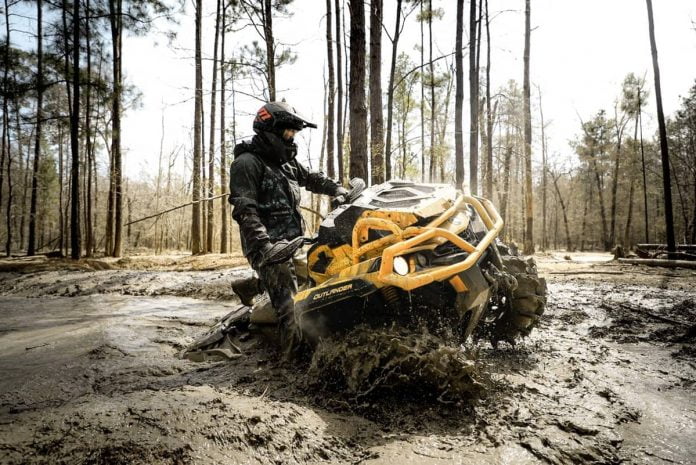Some people buy ATVs solely to take them mudding on the weekends. However fun and challenging it can be, how does an ATV hold up against this extreme form of off-roading?
Mudding can be highly taxing on the ATV, requires modifications to prevent vehicle damage, and requires frequent cleaning and maintenance to ensure the vehicle remains in good condition.
What is ATV Mudding?
Mudding or mud bogging is a form of off-road riding where the goal is to ride your vehicle, in this case, an ATV, through a mud pit or a muddy track.
In the United States and Canada, mud bogging competitions, also known as mud racing, mud running, or mud drags) is a popular form of off-road motorsport where riders compete in distance traveled and time across the mud pit.
Unorganized mudding is a popular weekend activity where friends gather with their off-road vehicles at their local mud pit to have fun and test their vehicle’s capacity.
How Is Mudding Bad for Your ATV?
Mudding is considered an extreme form of ATV riding that falls under the definition of “Severe use” in most ATV owners’ manuals.
But how exactly does riding in deep mud impact your ATV?
Mud and Water May Damage the Engine
Stock ATVs are not designed to go through deep mud and water. In fact, most stock ATVs should not go in water deeper than the bottom of the footrests.
When riding in deep water or mud, the liquid may enter the engine through the air intake, causing the engine to water lock.
If an engine water locks when working at full power, there is a high risk of severe engine damage or failure.
Related: 16 Steps to Repair an ATV Submerged in Mud or Water
Mud and Water May Cause Belt Slipping
While not as severe as water locking the engine, mud, and water entering the CVT clutch housing is not good either.
Most ATVs use a CVT (Continuously Variable Transmission) with two variable clutches connected by a rubber drive belt. The clutches are contained inside clutch housing with air vents to keep the clutches cool.
If water or mud enters the clutch housing through the air inlet or outlet port, the drive belt will likely begin to slip. Belt slippage leaves the ATV unable to move and may damage the belt if you continue to ride until the clutch housing is drained.
Electrical Connections and Components May Corrode
Electrical connections exposed to mud and water are prone to corroding, causing electrical issues due to bad connections.
In addition, electrical components like the ECU, solenoids, and relays may become damaged if moisture gets inside.
A Radiator Plugged by Mud May Cause Overheating
The radiator on a water-cooled ATV relies on a constant flow of cool air to prevent the ATV from overheating.
When you drive in deep mud, the radiator is prone to get packed with dirt and debris, severely reducing its cooling capacity.
When the radiator is caked with mud, the ATV may overheat even if you drive in deep, wet mud.
Overheating does not usually cause any damage if you stop and allow the ATV to cool down, but continued riding while overheating will cause severe engine damage.
Bearings, Joints, & Bushing May Wear Prematurely
Non-sealed wheel bearings, bushings, and axle joints will begin to corrode and wear faster if water gets inside.
While this can happen in any ATV, an ATV used in mudding is much more prone to this form of wear and damage.
Mud Can Stain Paints and Plastics
Mud left sitting on the ATV can cause stains on paints and plastics that are extremely hard to remove.
While mud stains do not affect the ATV’s performance, they can take years off its looks.
Mud Can Speed Up Corrosion in Metals
Mud left sitting on the ATV contains moisture that speeds up corrosion in unpainted metals and where the paint is damaged.
How to Prevent Damage From ATV Mudding?
While mudding can potentially be very harmful and taxing on the ATV, there are a few things you can do so it will better sustain the suffering.
- Install a snorkel kit: Besides installing bigger wheels, adding a snorkel kit is one of the first things on our list of mudding mods. A snorkel kit raises the engine air intake and the clutch housing vents to reduce the risk of water getting into the system.
- Relocate the radiator: Many ATV mudders relocate higher up and away from the mud to reduce the risk of the radiator becoming caked with mud.
- Protect electrical connections with grease: Disconnect all electrical connections and pack them with di-electric (non-conducive) grease before putting them back together. This will prevent water from coming in contact and causing metal corrosion.
- Ensure all grease points are appropriately greased: Water is less likely to enter bearings, joints, and bushings if you ensure they are packed with grease. After you are done riding and cleaning the bike, apply fresh grease to drive out any remaining moisture.
- Plan for more frequent maintenance intervals: Severe ATV use, like mudding, requires a tighter maintenance schedule and more frequent oil change intervals. Make sure to regularly inspect the engine oil, differentials, and transmission oil for water and change if there are any signs of water contamination (milky brown oil).
